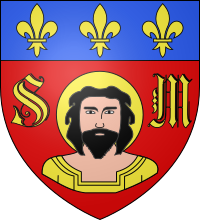Carnation (heraldry)
In heraldry, carnation is a tincture, the name for skin colour,[1][2] more exactly the colour of pale or white human skin[3] (i.e., pale pinkish peach).


It is rare in coats of arms in Anglophone countries but quite frequent on the European continent, in France in particular, derived from widespread use in German heraldry. In its rare appearances in the Anglophone heraldries, it is not only used for European flesh tones as in a crown rayonny or supported by two cubit arms, dexter carnation, sinister skeletal proper (crest of The Royal Australian and New Zealand College of Radiologists)[4] but also as a general pink colouring as in a horse passant argent bridled saddled and trappings or, on its head a plume of three feathers carnation (crest of The Worshipful Company of Saddlers, England).[5]
References
- Friar, Stephen, ed. (1987). A New Dictionary of Heraldry. London: Alphabooks/A&C Black. p. 81. ISBN 0 906670 44 6.
- Cadogan Rothery, Guy (1915) [1994]. Concise Encyclopedia of Heraldry. London: Senate, an imprint of Studio Editions Ltd. p. xvii. ISBN 1 85958 049 1.
- Mike Oettle. "Colours of dye". Armoria. Archived from the original on 1 February 2014. Retrieved 30 January 2014.
- "Coat of Arms: History and meaning of the College's Coat of Arms". The Royal Australian and New Zealand College of Radiologists. Retrieved 28 January 2014.
- "Arms of the Saddlers Company". The Worshipful Company of Saddlers. Retrieved 28 January 2014.